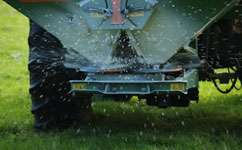Calculate your nitrogen footprint

Carbon footprints are a familiar way to assess how green your lifestyle is, but now you can also measure your nitrogen footprint using a new tool, the N-Calculator.
Pure nitrogen is a harmless gas that makes up 80 per cent of the atmosphere, but other forms of nitrogen are pollutants that cause health problems, acid rain, water pollution, damage to crops and climate change. The main sources are agriculture and fuel combustion.
'Nitrogen fertilizer is essential for growing crops or high quality grass for cattle, as any farmer knows,' says Professor Paul Whitehead of the University of Oxford, who leads the NERC Macronutrient Cycles Programme. 'But this has resulted in a runoff of excess nitrogen from farms into our rivers, lakes and groundwater.' This encourages the growth of toxic algal blooms that smother all other life in the water.
Fuel combustion creates acidic nitrogen oxide gases that irritate the lungs. Vehicles are the main problem, giving rise to the brown haze that hangs over polluted cities. Nitrogen oxides also react with other pollutants to form ozone. Although the ozone layer high up in the stratosphere protects us from ultraviolet radiation, ozone at ground level damages the lungs, causes asthma and restricts the growth of crops and trees, as well as being a greenhouse gas.
Fertilizer use and fuel combustion also emit nitrous oxide (N2O) – a greenhouse gas over 300 times stronger than carbon dioxide. And all nitrogen pollutants form nitric acid when dissolved in water, leading to acidic rain, soil and lakes and harming plants and animals.
Dr Carly Stevens of Lancaster University developed the new tool in collaboration with the University of Virginia with the aim of raising the awareness of the problem. 'I think nitrogen pollution both in the air and the water is less recognized than some other pollutants,' she says. 'I'm hoping that the tool will allow people to see that small changes, particularly to their diet, can cut their nitrogen footprint.'
If you enter information on what you eat, how you travel and how much energy you use in your home, the N-Calculator will work out your nitrogen footprint. You can then see how you could reduce your footprint - for example by eating less meat, driving and flying less or switching to renewable energy.
'The more meat you eat, the higher your nitrogen footprint,' explains Stevens. Nitrogen fertilizer is used to grow the grass or crops that livestock eat, and some of this nitrogen is then excreted as manure. The larger the animal, the higher the nitrogen footprint because it takes longer for the animal to reach its market weight, so more nitrogen is lost along the way. So beef generates twice as much nitrogen as pork, and almost three times as much as chicken or fish.
The tool is already being used as a teaching aid at US and UK universities, and Dr Stevens hopes that it will also be used in schools. 'It's a really good way of understanding where nitrogen pollution comes from,' she says. 'Even quite young children can put in what food they eat and see what their footprint is.'
The N-Calculator was originally created by scientists at the University of Virginia in the US, and at ECN and the Louis Bolk Institute in the Netherlands. It has been updated and adapted for UK users by the University of Lancaster under a project funded by the NERC Macronutrient Cycles programme.
More information: N-Calculator tool
Provided by PlanetEarth Online
This story is republished courtesy of Planet Earth online, a free, companion website to the award-winning magazine Planet Earth published and funded by the Natural Environment Research Council (NERC).


















